|
|
|
Pictish Symbol Stones
I cannot remember when I first became interested in the Picts and things Pictish. I think it stems from an interest since childhood in old and magical things - stories, mythology and Jackanory; with Magnus Magnusson retelling Icelandic sagas! Moving from Aberdeen to the Shire in the early eighties and learning to drive meant that I could now go and seek out the places in books and on maps that had fascinated and drawn me.
The Picts are the first people of Scottish history. Apart from some monastic records of the names of some of the kings, very little written material remains, except for the enduring legacy of the sculpured stones, along with a few silver artifacts, inscribed with the enigmatic and mysterious symbolic inscriptions.
The first recorded mention of the Picts comes from a Roman poem written in the late 3rd Century AD. and refers to Picti or painted men. The Pictish peoples of the area of Scotland north of the Antonine wall spanning the Forth-Clyde divide, were never brought under Roman rule. The Roman writer Ammianus Marcellinus records in 368AD that " the Picts, divided into two tribes .... were creating havoc", and their fierceness in battle and frequent raids and skirmishes into Roman Britain are chronicled by the Roman writers. It has been suggested that this very fierceness and fierce independance explains the lack of written information about the Picts. Perhaps if they had not been so totally outside of the literate Roman Empire then more details of their society would have been recorded for posterity.
By the 5th century AD the Romans had withdrawn from Britain and the various tribes appear to have united, perhaps this unity coming about as a result of the need for a combined fighting force against the Romans, and Irish records refer to this people of this part of the North of Scotland, whom the Romans called the Picts, as the Cruithni- the people of the designs.
Irish legend tells that the Picts were a race from near the Black Sea that helped the Irish in their battles. The Irish then helped them to settle over the sea in Alba, giving them the widows of dead Irish warriors as their wives on condition that they always selected their kings from the female line. Some schools of thought dispute the idea that the Picts were remnants of an earlier Mother-goddess society. Such societies have existed and much evidence exists which suggests that these mother-moon worshipping societies were displaced by patriarchal sun-worshipping ones. Anthony Jackson senior lecturer in Social Anthropology at Edinburgh University 1989 proposes in his book 'The Quest for the Picts' that the Pictish people did indeed have a system where descent is reckoned through the mothers line, or matrilinear. Power going not from a man to his son, but through the female line from a man to his sister's son. Jackson suggests that the symbols on the stones, which most often occur in pairs, relate to and record the unions or marriages between the powerful clans or families of this matrilinear society. The much earlier stone circles of this area from the late Neolithic or early Bronze age period (3500 BC-2200 BC) appear to have their recumbant stone - a gigantic megalith lying on it's side between two upright flanking stones, with their flattened surfaces designed and aligned to observe the moon as it arcs across the sky. Many of these circles contained stones of quartz, a white crystalline rock, or, as in the circle at Strichen, shattered pieces of quartz rock strewn inside of the circle in an arc mimicking the crescent moon.
The upsurge of Victorian interest in archaeology and antiquities brought public attention to the sculptured stones and culminated in the publication of the study and classification of the stones - The Early Christian Monuments of Scotland by J.Romilly Allen & Jos. Anderson. Edin. 1903. I have included a table of the basic set of symbols as numbered in the book and have indicated the number referring to the symbols in the photographs I have included in these pages, for clearer identification.
This work also classified the stones into three groups, Class I stones have symbols cut into rough boulders with little or no dressing. Class II stones have the symbols, now in relief, on shaped and dressed stones, additional figures also appear, with a Christian cross on the reverse side. Class III stones have no symbols. They portray figures and a cross.
Some Class I stones from the Aberdeenshire area.
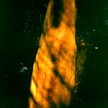 This is a thumbnail of one of
the Newton stones, click to view a larger version.
This is a thumbnail of one of
the Newton stones, click to view a larger version.
Newton House (NH 805717)
This two-metre high stone found now stands in the private garden of Newton House having been moved from it's original location. features a double disc (3) above a snake and Z-rod (45). The double disc has been interpreted as possibly representing a union or marriage. The Z-rod is found crossing a snake, as here, also a double disc or a notched rectangle. It has been seen as a broken spear, representing death or possibly martial prowess. Snakes are associated in many cultures worldwide with magic, death and rebirth. This stone stands in a private garden beside another stone with no symbols but which has an inscription reading EDDARRNONN in Ogham, a linear based form of writing.
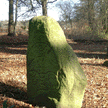 This is a thumbnail of one of
the stones at Logie Elphinstone, click to view a larger
version.
This is a thumbnail of one of
the stones at Logie Elphinstone, click to view a larger
version.
Logie Elphinstone, Pitcaple (NJ 703259)
This stone, one of a group of three, was moved to the private grounds of Logie Elphinstone House from the Moor of Carden in the 19th century, during the upsurge of interest of the Victorian gentry in antiquarian objects. It carries a crescent and V-rod (8) and a double disc (3).
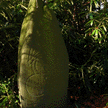 Second
stone showing Ogham , symbols 13 and 5, click on the thumbnail for a
larger version.
Second
stone showing Ogham , symbols 13 and 5, click on the thumbnail for a
larger version.
The other stones show - a rare example of 'wheel' Ogham, with a circle forming the basis for the letters instead of the usual straight line with a crescent and V-rod (8) and a double disc and Z-rod (5); the third stone bears a symbol known variously as a Pictish beast, a swimming elephant or a dolphin (31), and a crescent and V-rod(8). The symbol (31) is unique among the symbols depicting animals in that unlike the others (snakes, salmon, deer,bulls etc.) it does not accurately portray any real beast. It makes up about 40% of the symbols depicted on all of the stones which are spread over a wide area of the North-east, suggesting that it carried some important meaning. Perhaps it depicts a 'kelpie' or water-horse, a water spirit that is said to haunt many lochs. Perhaps this is a powerful mythical symbol, like a dragon or a unicorn. This symbol can be seen more clearly on the next stone, as this stone is quite weathered and difficult to photograph.
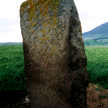 The 'Craw stane' showing a
Pictish beast below a salmon, click on image to view a larger
version.
The 'Craw stane' showing a
Pictish beast below a salmon, click on image to view a larger
version.
The Craw Stane, Rhynie (NJ 497263
This stone stands in a field outside the village of Rhynie. Another seven symbol stones have been found in this area. Two are in the village green, one showing a just discernible double disc and Z-rod (5); the other a badly weathered figure carrying a spear. Another two stand at the entrance of the graveyard: one has a crescent and V-rod (8), part of a double disc and Z-rod (5) along with a mirror on its own without the comb (24). Two others, including the 'Rhynie Man' a representation of a figure with fierce, sharpened teeth and wielding an axe, are located in the head quarters of Aberdeenshire Council at Woodhill House, Aberdeen. The final stone recorded as depicting a Pictish beast (31), a crescent and V-rod (8) and a Mirror (24) is now lost.
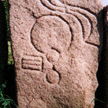 Thumbnail of stone at Drimmies
Farm. Click to view a larger picture.
Thumbnail of stone at Drimmies
Farm. Click to view a larger picture.
Drimmies Farm, Inverurie. (NJ 743235)
This fine stone now forms part of a gatepost at Drimmies Farm on the outskirts of Inverurie and shows a mirror with double sided comb (24) below an S-shaped design (14) which could represent a swathe of cloth. Another suggestion is that it may be a sharp-edged implement such as a razor.
Class II stones
The Maidenstone, near Chapel of Garioch, Inverurie (NJ 704247)
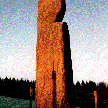 Click on image for larger
picture.
Click on image for larger
picture. ![]()
There are few class II stones in the Aberdeenshire area, most of this class of stones occur further South in Angus and Perth areas. This symbol-stone stands by the side of an unclassified road some 5 miles North-West of Inverurie. It is an upright slab of red granite some 3 metres high. It is now somewhat weathered but the fine relief carvings can still be made out, they are most visible when lit by the sun at an angle to the stone.
The thin edges of the North and South facing sides are covered with flowing knotwork and interlaced designs respectively. The Eastern face boasts several Pictish symbols and fabulous beasts, including the mirror and comb symbol (24), the Pictish beast (31) and the notched rectangle and Z-rod (23). This last symbol has been interpreted as a stylised chariot or gateway. The fabulous beasts at the top of the stone are rather worn, but a centaur-like figure can still be seen.
On the reverse side a ringed Celtic cross can be seen in the centre topped by a carving of a man surrounded by fish-monsters. This is possibly a representation of the story of Jonah and the whale from the Old Testament. The cross surmounts a roundel containing patterns incorporating double and triple spirals, surrounded by a ring of key pattern with knotwork corners forming a square.
Local legend has it that a daughter of the Laird of Balquhain made a bet with the devil, who had called at the house in disguise, that she could bake a supply of bread before he could build a road to the summit of Bennachie. The devil won the bet, thus creating The Maiden's Causeway, a cleared route to top of the hill which can be seen today. The woman then fled but was caught and turned to stone.
The stone at Dyce near Aberdeen has been moved to safe accommodation while the ruined medieval church where it was located is being renovated.
I hope to visit Monymusk soon and will add pictures of the stone and it's symbols (19) a stepped rectangle and (4) a triple disc with rod resembling a cauldron viewed from above.
We can offer Bed and Breakfast facilities for any one wishing coming to this area and are ideally placed for exploring and visiting the wealth of antiquities and sites of archaeological and historical interest here. Visit our B&B page for more info.
|
|